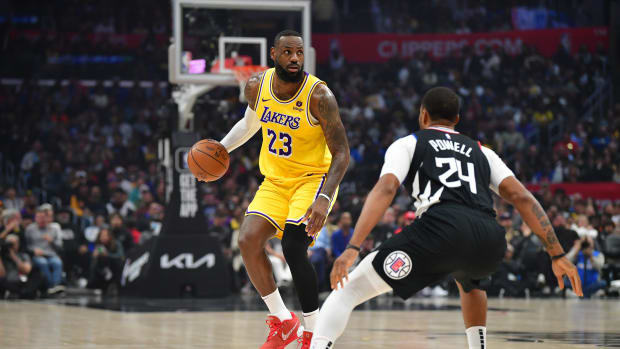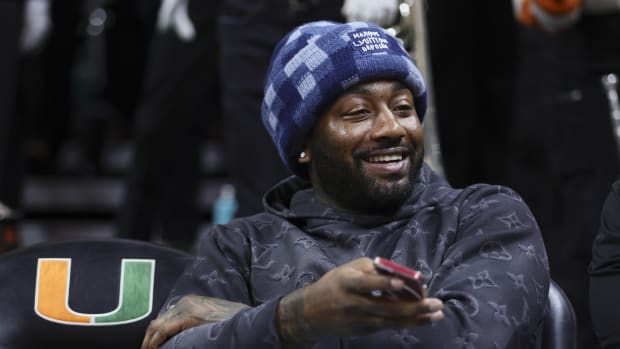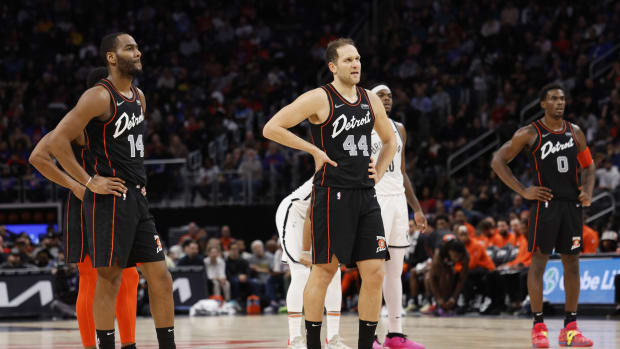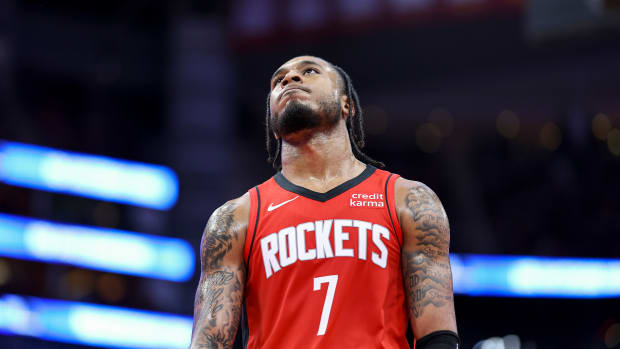There’s Never Been a Stretch Four Like Blake Griffin
The very idea of a stretch big conjures the passive—spacing by way of standing around at just the right distance. There is virtue, after all, in keeping out of the way. The more that an opposing defense is forced to respect threats outside the paint, the more strained their rotations become. If the defenders in question are bigs, then all the better. A rim protector can be brought to existential crisis when he isn’t physically around the rim enough to protect it. Even the best defenders in the league can only cover so much ground in a fraction of a second, which gives an offense real incentive to station shooters, big and small alike, as far from the basket as possible.
Brook Lopez, somewhat improbably, has become a standard-bearer for the archetype. No Giannis Antetokounmpo drive is complete without Lopez waiting in the wings, daring opponents to leave him under penalty of open three. One can find variations on this theme from P.J. Tucker to Omari Spellman, all spotting up and waiting patiently for the ball to swing their way. Blake Griffin is the exception.
MANNIX: Is Westbrook a Good Teammate? The Side We Don't See
The most prolific and successful three-point shooting season of Griffin’s career has been a complete stylistic outlier. Lopez takes a similar number of threes per game, but a whopping 97% of his makes are assisted—functionally created by someone else. Griffin shatters that mold. Not content to be a stretch big like Lopez or a playmaking big a la Draymond Green, Griffin has merged the two designations, assuming creative control of the Pistons’ offense in the process. Logistically speaking, no big in the league has the ball in their hands as much as Griffin, according to NBA.com. Some of that usage is familiar, enacted through bully-ball post-ups and whirling attacks from the elbow. Much of it, however, is entirely new.
The entire story of Griffin’s career could be told through the pick-and-roll. It was that very mechanism that made every game of the lottery-bound Clippers a can’t-miss event back in 2010—a League Pass revelation if there ever was one. It was on the roll that Griffin vaulted over Timofey Mozgov (and Kendrick Perkins, and Roy Hibbert, and Pau Gasol…) and into full-fledged stardom. And what was Lob City if not an expression of Griffin at the height of his rolling prowess? Griffin was literally left giddy by the notion of teaming up with Paul, who could read any defense while Griffin rose above it. Even as Griffin rounded out his game, the flexibility afforded by his catching the ball on the move and making plays in traffic helped carry one of the best (if ill-fated) teams of its era.
The pick-and-roll is no less vital to Griffin as a Piston, though his perspective has shifted. According to Synergy Sports, Griffin uses possessions as the ball-handler in the pick-and-roll nearly three times as often as he rolls, turning the defining sequence of his career upside-down. Now, it’s Griffin in control—dictating terms, sizing up coverages, parsing when to dish and when to attack. It’s not unusual to see the shot distribution of a big drift outward over time, particularly for those with so extensive an injury history as Griffin. Rarely, however, do those bigs end up handling the ball more in the process. This is a clever inversion on the part of Pistons coach Dwane Casey and a complete reinvention of Griffin’s game at almost 30 years old, most clearly exemplified by the fact that Griffin—who only took threes with any real frequency for the first time last season—is now launching those shots off the dribble with regularity.
What a world. Griffin now takes more pull-up three-pointers per game than LeBron James, Kevin Durant, Kyrie Irving, and C.J. McCollum, per NBA.com, while making a crisp 41.1%. Today’s bigs are emboldened to handle the ball and to shoot from outside, but never in quite this fashion. This isn’t a wrinkle or a counter. This is how the Pistons run their offense: by unleashing Griffin as a 6'10", 250-pound combo guard:
When Andre Drummond screens for Griffin, the Pistons test the defensive synergy of two less compatible parties: forwards not accustomed to chasing over the top of screens and centers who are used to an entirely different speed of recovery. If Reggie Jackson or one of the Piston wings screens for Griffin, switching becomes untenable and the calculus behind the coverage grows even more complicated. When faced with the unconventional, most defenses will fall back to protect the lane, surrendering open jumpers in the process. How does one batten down the hatches for the physicality of a Griffin drive while still honoring the threat of his shot? Defenders are still searching for balance.
SHARP: The Raptors Are Rolling and Kawhi Looks Like an MVP
Opponents will pack the paint against Detroit no matter who has the ball in their hands. Griffin, at least, offers some means of combating the crowd. A higher vantage point allows Griffin to find a way out via pass after driving in headlong. Muscle alone makes him a more resilient attacker than any guard could be, bouncing off bodies as he goes and holding others at bay with his off arm. We’ve seen Blake as a top scorer and a first option. This is something different: Griffin as the true, revolutionary engine of an offense that ceases to function without him. Given the quirks of its personnel, Detroit has no business being within a stone’s throw of league-average efficiency. It’s Griffin who makes it possible, and Pistons coach Dwane Casey who thought it so.


































